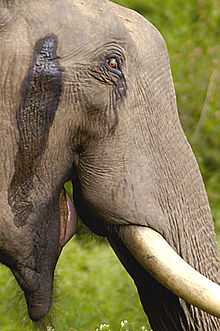Musth


Musth or must /ˈmʌst/ is a periodic condition in bull (male) elephants, characterized by highly aggressive behavior and accompanied by a large rise in reproductive hormones. Testosterone levels in an elephant in musth can be as much as 60 times greater than in the same elephant at other times. However, whether this hormonal surge is the sole cause of musth, or merely a contributing factor, is unknown; scientific investigation of musth is problematic because even the most placid elephants become highly violent toward humans and other elephants during musth, requiring segregation and isolation until they recover. Female elephants do not undergo musth.
Cause and effects

Although it has often been speculated by zoo visitors[1] that musth is linked to rut, it is unlikely there is a biological connection because the female elephant's estrus cycle is not seasonally-linked, whereas musth most often takes place in winter. Furthermore, bulls in musth have often been known to attack female elephants, regardless of whether or not the females are in heat. There has been speculation that musth is connected to natural periodic reorganization of dominance among males in elephant herds.
Often, elephants in musth discharge a thick tar-like secretion called temporin from the temporal ducts on the sides of the head. Temporin contains proteins, lipids (notably cholesterol), phenol and 4-methyl phenol,[2][3] cresols and sesquiterpenes (notably farnesol and its derivatives).[4] Secretions and urine collected from zoo elephants have been shown to contain elevated levels of various highly odorous ketones and aldehydes. The elephant's aggression may be partially caused by a reaction to the temporin, which naturally trickles down into the elephant's mouth. Another contributing factor may be the accompanying swelling of the temporal glands; this presses on the elephant's eyes and causes acute pain comparable to severe root abscess toothache. Elephants sometimes try to counteract this pain by digging their tusks into the ground.
Musth is linked to sexual arousal or establishing dominance, but this relationship is far from clear. Cases of elephants goring and killing rhinoceroses without provocation in national parks in Africa have been documented and attributed to musth in young male elephants, especially those growing in the absence of older males. Studies show that reintroducing older males into the elephant population of the area seems to prevent younger males from entering musth, and therefore, stop this aggressive behavior.[5][6]
In domesticated elephants
A musth elephant, wild or domesticated, is extremely dangerous to both humans and other elephants. In zoos, bull elephants in musth have killed numerous keepers when a normally friendly animal became uncontrollably enraged; in contrast to normal dominance behavior, bulls in musth will even attack and kill members of their own family, including their own calves. Zoos keeping adult male elephants need extremely strong, purpose-built enclosures to isolate males during their musth, which greatly complicates the expense of attempting to breed elephants in zoos; most zoos that keep a single elephant or a small herd typically have only females for this reason.
Domesticated elephants on musth in India are traditionally tied to a strong tree, or two strong trees, and denied food and water, or put on a starvation diet, for several days, after which the musth passes. Mahouts are often able to greatly shorten the duration of their elephants' musth, typically to five to eight days; xylazine (sedative) is also used.
Since denial of food and water is considered animal cruelty in most Western nations, the approved method in these countries is to strictly isolate the elephant in a highly fortified secure pen for a period ranging from 1 to 2 months until the elephant emerges from musth on its own. Medication against swelling and pain, as well as tranquilizers, are often mixed into the elephant's food. During this 1–2 month period the elephant cannot be trained, allowed outside or permitted to see other elephants, and must be fed, watered and cleaned by remote methods; they will surely attack any keeper attempting to approach them. Some Indian mahouts decry this method as more cruel than simply starving/dehydrating the animal for a week, upon which it recovers and can be safely reunited with the herd.
Etymology
In modern usage in Indian languages the word refers to a state of enjoyment, fun, pleasure or gratification—of any kind, experienced by humans or other creatures. In popular culture, the word is encountered frequently, in popular song lyrics, in the titles of Indian TV shows and in the titles of Indian movies, such as Mast, Masti (2004), the Kannada movie Masti (2007), etc.
References in popular culture
References to elephants in musth (whose temporin secretion is often referred to as "ichor") are frequent in classical Indian poetry and prose; for example, in the Raghuvaṃśa, Kalidasa says that the king’s elephants drip ichor in seven streams to match the scent put forth by the seven-leaved 'sapta-cchada' (= "seven-leaf") [7] tree (perhaps Alstonia scholaris). Some poets turn it around to compare the elephant’s ichor to the 'saptacchada'. The phenomenon has been described in poetry much before the time of Kalidasa, in Sanskrit, Tamil and Pali literature.
References
- ↑ http://www.upali.ch/musth_en.html
- ↑ Physiological Correlates of Musth: Lipid Metabolites and Chemical Composition of Exudates. L.E.L Rasmussen and Thomas E Perrin, Physiology & Behavior, October 1999, Volume 67, Issue 4, Pages 539–549, doi:10.1016/S0031-9384(99)00114-6
- ↑ Musth in elephants. Deepa Ananth, Zoo's print journal, 15(5), pages 259–262 (article)
- ↑ Sukumar, R (2003). The living elephants: evolutionary ecology, behavior, and conservation. USA: Oxford University Press. p. 155. ISBN 9780195107784. Retrieved 2010-12-25.
- ↑ "Killing of black and white rhinoceroses by African elephants in Hluhluwe-Umfolozi Park, South Africa" by Rob Slotow, Dave Balfour, and Owen Howison. Pachyderm 31 (July–December, 2001):14–20. Accessed 14 September 2007.
- ↑ Siebert, Charles (2006-10-08). "An Elephant Crackup?". New York Times Magazine. Retrieved 2007-06-16.
- ↑ "Saptacchada". venetiaansell.wordpress.com. Check date values in:
|accessdate=(help);
External links
| Wikimedia Commons has media related to Musth. |